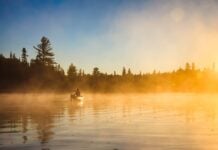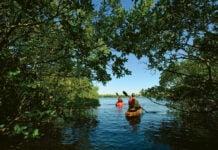Paddling on Lake Powell is a lesson in embracing contradiction. Behind a controversial dam, a massive reservoir winds like a ribbon through 150 miles of remarkable desert canyons. Of course, being located in one of the driest regions in the U.S., the reservoir is typically half full. The watercrafts of choice, in high season, are speedboats and houseboats which bounce waves between cliffs in the main channel. Many Southwestern paddlers hate Lake Powell so much, they call it Reservoir Powell, and refuse to even consider paddling there. BUT WAIT.
Other paddlers explore stunning side canyons, take overnight trips to remote bays, and even paddle across the entire reservoir. In recent years, Lake Powell has developed a growing paddling scene among dedicated locals and awestruck visitors. And those paddlers, including skeptics, who give the reservoir a chance often come away pleasantly surprised.
Kayak and SUP rentals at Lake Powell
The town of Page, Arizona, near Glen Canyon Dam, serves as regional hub for paddling at the southern end of the reservoir. Three companies offer rentals. For SUP rentals, check out Lake Powell Paddleboards and Kayaks. For kayak rentals, check out Kayak Lake Powell and Hidden Canyon Kayak.
For those seeking a more remote experience, the Hite Outpost is now operating on the north end of the reservoir, offering kayak and SUP rentals, plus an updated campground.
Kayak and SUP tours of Lake Powell
The three companies based in Page, listed above, each offer a variety of tours. The most common are half-day trips by kayak or SUP into the narrowing slot of Antelope Canyon or to Lone Rock Canyon in Wahweap Bay. Full-day and overnight trips will often motor paddlers and boats to more distant places, like Labyrinth Canyon and Padre Bay. At North Lake Powell, the new Hite Outpost plans to start offering tours in 2021.
Side canyons: The best place for paddling at Lake Powell
For most paddlers, Lake Powell is all about exploring side canyons. A great introduction to this experience is Antelope Canyon at the southern end of the reservoir, near Page. This is the lowest extremity of the famous Antelope slot canyon in the Navajo Nation.
To reach this side canyon, paddlers launch from Antelope Marina and paddle west for a mile on the main channel. Go early in the morning if you want to avoid the wakes from boat traffic in the main channel. Depending on reservoir level, water typically reaches two miles back into the narrowing Antelope Canyon. After that, you can hike another two miles through the twisty slot canyon that’s known as Lower Antelope Canyon, which is accessible only to small watercraft. Due to the risk of flash floods, do not explore slot canyons during thunderstorms.
Another popular and user-friendly area is northern Wahweap Bay, where you can paddle into Lone Rock Canyon. Further away, paddling at North Lake Powell offers a remote experience far from the southern scene.
Places to kayak and SUP near Lake Powell
The section of Colorado River between Glen Canyon and Lees Ferry goes by several names, including the Backhaul and Horseshoe Bend section. The run offers the final 15 miles of the Colorado River through Glen Canyon that’s not flooded by the reservoir. The water runs clear and cold, about 50 degrees Fahrenheit, from outlet pipes at the bottom of the dam. Since there’s no road access, paddlers and boats must be hauled upstream on a motorboat from Lees Ferry by Wilderness River Adventures.
Best time of year to visit Lake Powell
You can paddle at Lake Powell any time of year. Summer is hot and busy, but it’s still a nice way to cool off. Winter offers a nearly empty experience but expect cold temperatures and cold water.
The shoulder seasons, when the reservoir is less busy, can offer a good window for many paddlers. These windows will vary each season, given shifting weather patterns, so check conditions at Page, Arizona, before you go. For fall, target roughly late-September to early-November. During spring, consider March to early-May.
What to pack to kayak and SUP Lake Powell
Other than a party boater tossing you a beer (not likely, but also not impossible) prepare like you’re going desert hiking. An approved PFD must be worn by each paddler. Bring plenty of drinking water, food, sunscreen, a sun hat, a sun shirt, a sun dial—did I mention it’s very sunny out there?
That said, take some extra layers or splash jacket in case air temperatures drop and winds rise. Given the potential for waves, be prepared for possible immersion—water temperatures are colder during shoulder seasons and warm substantially during the summer.
Important things to know
The surface elevation of the reservoir is typically around 3,600 feet. Weather can appear with little warning. Be prepared for building clouds, rising winds, frequent waves and sudden thunderstorms. If this happens while paddling, head to shore and wait until conditions improve.
Access to the marina launch ramps in Glen Canyon National Recreation Area requires a $30 entrance fee per vehicle which is good for seven days.
Mike Bezemek is author and photographer of Paddling the John Wesley Powell Route: Exploring the Green and Colorado Rivers. The book combines a condensed retelling of the dramatic 1869 expedition with color photos and a trip guide to the 1,000-mile Powell Route, which includes Lake Powell.







